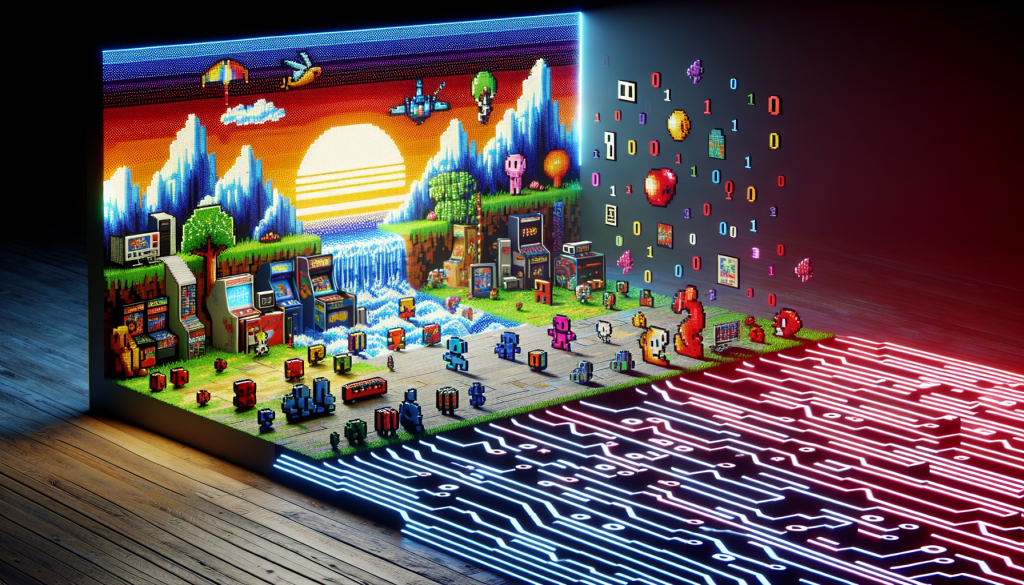Importance of Proper Storage and Preservation
Welcome, retro gaming enthusiasts! If you’re a collector of vintage video games, you already know how thrilling it is to delve into the nostalgia of classic titles. But have you considered the importance of proper storage and preservation for your precious game collection? Let’s dive into why it’s crucial and how you can ensure your retro games stand the test of time.
Preserving Gaming History
Retro games are not just items to display on your shelf or toys to play with; they are pieces of gaming history. These games paved the way for the titles we enjoy today, and preserving them is a way of honoring their contribution to the industry. Just like preserving art or literature, preserving retro games ensures that future generations can appreciate and learn from these digital artifacts.
Preventing Physical Damage
One of the main reasons for proper storage and preservation is to prevent physical damage to your retro game collection. These games are often fragile, with delicate cartridge connectors and sensitive labels. Improper handling or exposure to harsh conditions can lead to irreversible damage, including discoloration, label fading, or even the loss of game data. By taking the necessary precautions, you can protect your games from decay and ensure they remain playable for years to come.
Avoiding Environmental Hazards
Environmental hazards can pose a significant threat to the longevity of your retro games. Factors such as excessive heat, humidity, and direct sunlight can accelerate the deterioration process. It’s essential to store your games in a cool, dry place, away from direct sunlight and extreme temperature fluctuations. Consider investing in a climate-controlled storage solution or using protective cases to shield your games from potential harm.
Preventing Data Loss
Imagine the frustration of finding your favorite retro game, only to realize that the save data has been lost or corrupted. To prevent data loss, it’s vital to store your games properly and back up any save files or game progress. Consider using reliable storage mediums, such as memory cards or external hard drives, to ensure your precious memories are preserved.
Labeling and Organization
Proper organization is key when it comes to managing your retro game collection. Labeling your games and categorizing them by console, genre, or alphabetically can make it easier to locate specific titles when you want to play or showcase them. This not only saves time but also reduces the risk of accidental damage that can occur when games are mishandled during a search.
Investing in Protective Cases
To protect your retro games from dust, scratches, and accidental damage, investing in protective cases is a wise choice. Clear plastic cases or dust covers can shield your cartridges, CDs, or DVDs from harm while still allowing you to display them proudly. These cases not only offer physical protection but also add a touch of professionalism to your collection.
Proper Cleaning Techniques
Regular cleaning of your retro games can help maintain their quality and extend their lifespan. However, it’s crucial to use proper cleaning techniques to avoid causing damage. For cartridges, use a soft cloth or cotton swab dipped in isopropyl alcohol to gently clean the connectors. For CDs or DVDs, wipe them with a microfiber cloth from the center outward in straight lines. Avoid using abrasive materials or harsh chemicals that can harm the game’s surface.
Backup and Digital Preservation
As technology continues to advance, it’s becoming increasingly important to consider digital preservation for your retro games. Emulation software, such as RetroArch or virtual console services, allows you to play your classic games on modern devices while preserving the original hardware. Additionally, creating backup copies of your physical games can provide an extra layer of protection against damage or loss.
Sharing the Joy
Lastly, proper storage and preservation allow you to share the joy of retro gaming with others. Whether it’s through hosting gaming nights, lending games to trusted friends, or donating to museums, your well-preserved collection can bring happiness to fellow gamers and contribute to the wider appreciation of gaming history.
Organizing Your Retro Game Collection
So, you’ve amassed a fantastic collection of retro games, but now what? How do you keep them organized in a way that makes it easy for you to find and enjoy them? Fear not, because I’m here to guide you through the process of organizing your retro game collection!The first step in organizing your collection is to categorize your games. You can do this in various ways, depending on your personal preferences. One popular method is to sort your games by console. This means grouping all your NES games together, all your Sega Genesis games together, and so on. This not only helps you locate games more easily, but it also gives your collection a neat and organized look.
Another approach is to organize your games alphabetically. This can be done by the title of the game or by the console name. For example, you can have all your “Legend of Zelda” games grouped together, regardless of the console they were released on. This method is particularly useful if you have a large collection spanning multiple consoles.
Once you’ve decided on a categorization method, it’s time to physically organize your games. There are various options for storing your retro games, depending on the size of your collection. One popular choice is to use plastic storage bins or shelves with individual compartments. This not only protects your games from dust and damage but also makes it easy to access and display them. Alternatively, you can opt for specialized game storage cases or even custom-made shelving units to showcase your collection.
In addition to organizing your games, it’s important to keep them in good condition. Always handle the games with clean hands and avoid touching the sensitive parts, such as the golden connectors on cartridges. If a game has a case or box, make sure to store it properly to prevent any damage. It’s also a good idea to periodically clean your games and consoles to ensure they function properly.
Now that your retro game collection is organized, you might want to showcase some of your most valuable games. One great way to do this is by creating a display area in your gaming room or living space. You can use floating shelves or wall-mounted display cases to show off your prized possessions. Consider adding some decorative elements, such as LED lights or posters, to enhance the visual appeal of your display.
Remember, it’s important to protect your valuable games from theft or damage, especially if you plan on showcasing them. Consider installing security measures, such as cameras or alarms, to deter any potential thieves. Additionally, make sure to keep your display area well-maintained and free from any hazards that could potentially harm your games.
Lastly, don’t forget to regularly update your collection inventory. This will help you keep track of what games you have and what you might be missing. You can create a simple spreadsheet or use a dedicated app or website to manage your collection. This way, you’ll always know what gems are hiding in your retro game collection.
So there you have it, a guide to organizing your retro game collection. Remember to choose a categorization method that suits your preferences, invest in proper storage solutions, and showcase your most valuable games proudly. With a well-organized and protected collection, you’ll be able to enjoy your retro gaming adventures for years to come!
So you’ve built up an impressive collection of retro games, filled with nostalgic titles from your childhood or rare gems you’ve discovered along the way. Now, you want to showcase these valuable treasures and share your love for retro gaming with others. But how do you go about doing that? Let’s dive into the third heading of our discussion: showcasing valuable retro games.
Creating a Display
When it comes to showcasing your retro game collection, the first step is to create a visually appealing display. This not only enhances the aesthetics but also keeps your games organized and protected.
One popular option for displaying retro games is to use shelving units or bookcases. These provide ample space to arrange your games in an organized manner, making it easy to find and access them. Consider investing in sturdy, adjustable shelves to accommodate different sizes of game cartridges or discs.
To add a touch of creativity to your display, you can arrange your games by genre, release date, or even color. This not only makes it visually appealing but also makes it easier for you to find specific games when you’re in the mood for a particular genre or theme.
Another option for showcasing your retro games is to use display cases. These transparent cases allow you to protect your games from dust, sunlight, and potential damage while still showcasing them in all their glory. Display cases are particularly useful for displaying rare or valuable games that you want to keep in pristine condition.
When setting up your display, it’s important to consider lighting. Proper lighting can make a huge difference in highlighting the artwork and details of your retro game collection. Avoid direct sunlight, as it can fade the colors and damage your games over time. Instead, opt for ambient or LED lighting to create a warm and inviting atmosphere.
Adding a Personal Touch
While displaying your retro games, don’t be afraid to add a personal touch that reflects your passion for gaming. You can include framed artwork or posters related to your favorite games or consoles. This not only adds visual interest but also creates a conversation starter for fellow gaming enthusiasts.
You can also incorporate gaming memorabilia, such as figurines, plushies, or replicas of iconic gaming items. These can be placed strategically among your game collection, adding depth and personality to the overall display.
If you have a particularly rare or valuable game, consider placing it in a separate display case or stand to give it the attention it deserves. This helps draw attention to its significance and serves as a centerpiece for your collection.
Sharing Your Collection
Now that you have a stunning display of your retro game collection, it’s time to share it with others. You can invite friends over for a gaming night, where they can experience the nostalgia and excitement of playing retro games. Consider setting up multiple gaming stations with different consoles and games to accommodate different preferences.
You can also consider participating in gaming conventions or local meetups to meet fellow retro gaming enthusiasts. These events provide an opportunity to showcase your collection, share stories, and even engage in friendly gaming competitions.
Additionally, you can create an online presence for your retro game collection by sharing pictures and stories on social media platforms or gaming forums. This allows you to connect with a wider audience of like-minded individuals who share your passion for retro gaming.
Remember, the purpose of showcasing your retro game collection is not just to display your games but also to share your love for gaming and connect with others who appreciate the nostalgia and joy that retro games bring. So, get creative, have fun, and let your collection shine!
Additional Tips for Protecting and Displaying Retro Game Collections
So, you’ve organized your retro game collection and showcased your valuable pieces. Now, it’s time to talk about some additional tips for protecting and displaying your treasures. These tips will help ensure that your collection remains in great condition and continues to bring you joy for years to come.Proper Storage
First and foremost, proper storage is crucial for preserving your retro games. Here are a few tips to keep in mind:- Keep them away from direct sunlight: Sunlight can fade the labels and artwork on game cartridges and boxes. Store them in a cool, dark place to prevent any damage.
- Use protective sleeves: Slip your game cartridges into protective sleeves to prevent scratches and dust accumulation.
- Store them upright: Storing your games upright, rather than stacked on top of each other, can help prevent any potential damage to the labels and connectors.
Invest in Display Cases
If you want to showcase your retro game collection while still keeping them safe, investing in display cases is a great option. Here’s why:- Protection: Display cases provide a barrier against dust, moisture, and accidental damage.
- Visibility: Clear display cases allow you to enjoy the artwork and design of your game cartridges without having to touch them.
- Organization: Display cases can be arranged in a way that makes it easy to find and retrieve specific games from your collection.
Regular Cleaning
Keeping your retro games clean is essential for their preservation. Here are some cleaning tips to keep in mind:- Use a soft cloth: Gently wipe the game cartridges and boxes with a soft, lint-free cloth to remove any dust or fingerprints.
- Avoid harsh chemicals: Use cleaning solutions specifically designed for video game cartridges. Avoid using harsh chemicals that may damage the plastic or labels.
- Handle with care: When cleaning, always handle your games with clean hands and avoid touching the connectors.












